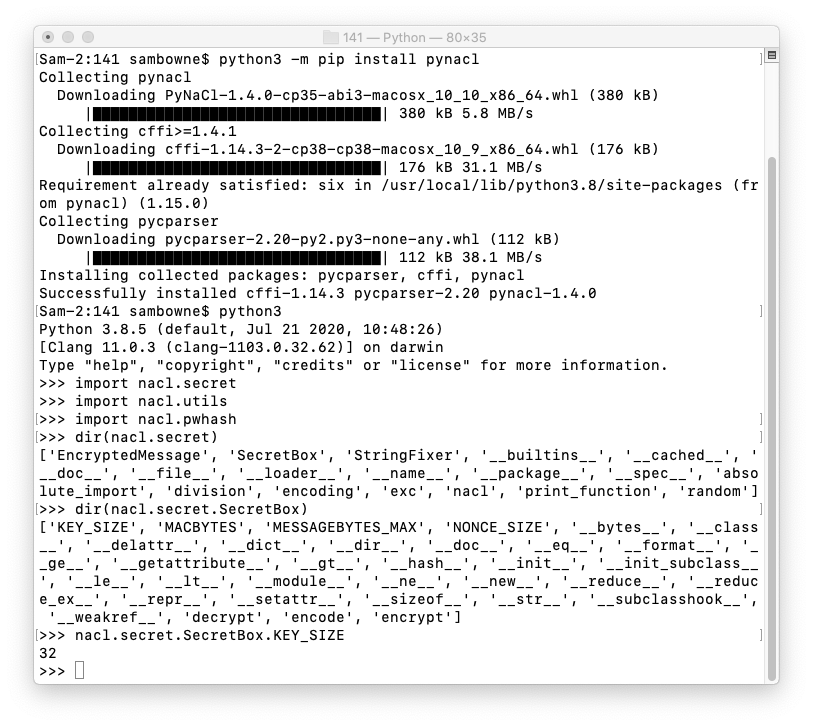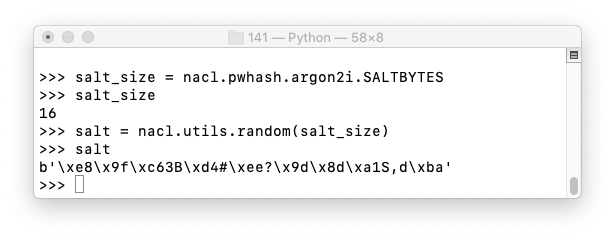
In a Terminal window, execute these commands:
sudo apt update
sudo apt install python3-pip python3-full -y
mkdir sodium
python3 -m venv sodium
./sodium/bin/pip install pynacl
./sodium/bin/python3
import nacl.secret
import nacl.utils
import nacl.pwhash
dir(nacl.secret)
dir(nacl.secret.SecretBox)
nacl.secret.SecretBox.KEY_SIZE
This is the private key and it is 32 bytes long (256 bits).

help(nacl.secret.SecretBox)
To exit the help message, press Q.

To see how it works, execute these commands.
(Notice the definition of kdf -- that will make later commands shorter.)
dir(nacl.pwhash)
dir(nacl.pwhash.argon2i)
dir(nacl.pwhash.argon2i.kdf)
kdf = nacl.pwhash.argon2i.kdf
help(kdf)
To exit the help message, press Q.

salt_size = nacl.pwhash.argon2i.SALTBYTES
salt_size
salt = nacl.utils.random(salt_size)
salt

To derive a key from the password topsecret, execute these commands:
password = "topsecret".encode("utf-8")
key = kdf(nacl.secret.SecretBox.KEY_SIZE, password, salt)
key
The key derivation is slow--it took about 3 seconds on my system. This makes it very secure, because an attacker would need a very long time to generate a dictionary of password hashes.

The process is deterministic: if you save the the salt and the password, you can recalculate the private key from them.
plaintext = b"HELLO"
box = nacl.secret.SecretBox(key)
ciphertext = box.encrypt(plaintext)
ciphertext

decrypted = box.decrypt(ciphertext)
decrypted

Execute these commands to convert the ciphertext to Base64 and back.
import base64
b64text = base64.b64encode(ciphertext).decode("ascii")
b64text
decoded = base64.b64decode(b64text)
decoded

C 430.1: Decryption with the Key (5 pts)
This Python code specifies ciphertext:Decrypt it with this key to find the flag:
C 430.2: Decryption with the Password (10 pts)
Decrypt this to find the flag:
- Salt: 1111222233334444
- Password: password
- Ciphertext (Base64-encoded): 9BIneuYE5L5tfYVHHLt+VV/r1kWc/kNVMRZdzW17+d5cl+251VilbMfWAErmYFDhidZJGW8=
C 430.3: Guess the Password (20 pts)
Decrypt this to find the flag:
- Salt: abcdefghijklmnop
- The password is in this list: example.dict (alternate source: example.dict.zip)
- The password contains this string: kitten
- Ciphertext (Base64-encoded): hye3wygUWRQOiLrmqQNQZPKquKdwqdwSHDagK9cvUqT258w5kboSjXuzFgFFOft7TFcokN1a8Bk=
C 430.4: Guess the Password (30 pts)
Decrypt this to find the flag:
- The salt is one digit repeated 16 times, like 5555555555555555
- The password is is from the same list as the previous challenge
- The password is more than 12 characters long
- The first character and the last character in the password are the same
- Ciphertext (Base64-encoded): KI8HpwBpIVaJaKE4sNuYBpxalojdQBHDJ6pLWcM4aTYJhgYdH7sQ5DhzXYx3sFxjg4BCAunFziUy